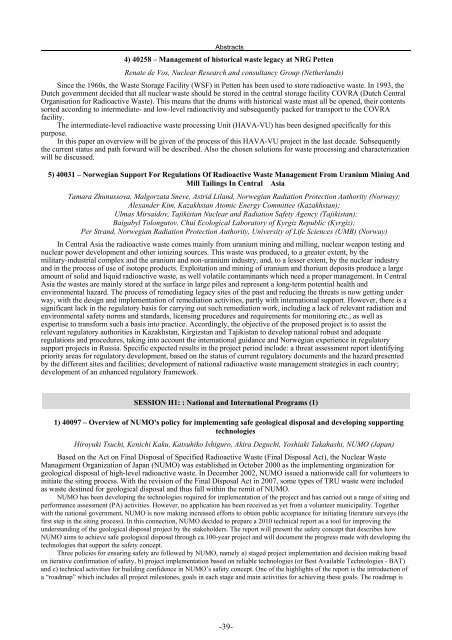ASME Message
ASME Message
ASME Message
Create successful ePaper yourself
Turn your PDF publications into a flip-book with our unique Google optimized e-Paper software.
Abstracts<br />
4) 40258 – Management of historical waste legacy at NRG Petten<br />
Renate de Vos, Nuclear Research and consultancy Group (Netherlands)<br />
Since the 1960s, the Waste Storage Facility (WSF) in Petten has been used to store radioactive waste. In 1993, the<br />
Dutch government decided that all nuclear waste should be stored in the central storage facility COVRA (Dutch Central<br />
Organisation for Radioactive Waste). This means that the drums with historical waste must all be opened, their contents<br />
sorted according to intermediate- and low-level radioactivity and subsequently packed for transport to the COVRA<br />
facility.<br />
The intermediate-level radioactive waste processing Unit (HAVA-VU) has been designed specifically for this<br />
purpose.<br />
In this paper an overview will be given of the process of this HAVA-VU project in the last decade. Subsequently<br />
the current status and path forward will be described. Also the chosen solutions for waste processing and characterization<br />
will be discussed.<br />
5) 40031 – Norwegian Support For Regulations Of Radioactive Waste Management From Uranium Mining And<br />
Mill Tailings In Central Asia<br />
Tamara Zhunussova, Malgorzata Sneve, Astrid Liland, Norwegian Radiation Protection Authority (Norway);<br />
Alexander Kim, Kazakhstan Atomic Energy Committee (Kazakhstan);<br />
Ulmas Mirsaidov, Tajikistan Nuclear and Radiation Safety Agency (Tajikistan);<br />
Baigabyl Tolongutov, Chui Ecological Laboratory of Kyrgiz Republic (Kyrgiz);<br />
Per Strand, Norwegian Radiation Protection Authority, University of Life Sciences (UMB) (Norway)<br />
In Central Asia the radioactive waste comes mainly from uranium mining and milling, nuclear weapon testing and<br />
nuclear power development and other ionizing sources. This waste was produced, to a greater extent, by the<br />
military-industrial complex and the uranium and non-uranium industry, and, to a lesser extent, by the nuclear industry<br />
and in the process of use of isotope products. Exploitation and mining of uranium and thorium deposits produce a large<br />
amount of solid and liquid radioactive waste, as well volatile contaminants which need a proper management. In Central<br />
Asia the wastes are mainly stored at the surface in large piles and represent a long-term potential health and<br />
environmental hazard. The process of remediating legacy sites of the past and reducing the threats is now getting under<br />
way, with the design and implementation of remediation activities, partly with international support. However, there is a<br />
significant lack in the regulatory basis for carrying out such remediation work, including a lack of relevant radiation and<br />
environmental safety norms and standards, licensing procedures and requirements for monitoring etc., as well as<br />
expertise to transform such a basis into practice. Accordingly, the objective of the proposed project is to assist the<br />
relevant regulatory authorities in Kazakhstan, Kirgizstan and Tajikistan to develop national robust and adequate<br />
regulations and procedures, taking into account the international guidance and Norwegian experience in regulatory<br />
support projects in Russia. Specific expected results in the project period include: a threat assessment report identifying<br />
priority areas for regulatory development, based on the status of current regulatory documents and the hazard presented<br />
by the different sites and facilities; development of national radioactive waste management strategies in each country;<br />
development of an enhanced regulatory framework.<br />
SESSION H1: : National and International Programs (1)<br />
1) 40097 – Overview of NUMO's policy for implementing safe geological disposal and developing supporting<br />
technologies<br />
Hiroyuki Tsuchi, Kenichi Kaku, Katsuhiko Ishiguro, Akira Deguchi, Yoshiaki Takahashi, NUMO (Japan)<br />
Based on the Act on Final Disposal of Specified Radioactive Waste (Final Disposal Act), the Nuclear Waste<br />
Management Organization of Japan (NUMO) was established in October 2000 as the implementing organization for<br />
geological disposal of high-level radioactive waste. In December 2002, NUMO issued a nationwide call for volunteers to<br />
initiate the siting process. With the revision of the Final Disposal Act in 2007, some types of TRU waste were included<br />
as waste destined for geological disposal and thus fall within the remit of NUMO.<br />
NUMO has been developing the technologies required for implementation of the project and has carried out a range of siting and<br />
performance assessment (PA) activities. However, no application has been received as yet from a volunteer municipality. Together<br />
with the national government, NUMO is now making increased efforts to obtain public acceptance for initiating literature surveys (the<br />
first step in the siting process). In this connection, NUMO decided to prepare a 2010 technical report as a tool for improving the<br />
understanding of the geological disposal project by the stakeholders. The report will present the safety concept that describes how<br />
NUMO aims to achieve safe geological disposal through ca.100-year project and will document the progress made with developing the<br />
technologies that support the safety concept.<br />
Three policies for ensuring safety are followed by NUMO, namely a) staged project implementation and decision making based<br />
on iterative confirmation of safety, b) project implementation based on reliable technologies (or Best Available Technologies - BAT)<br />
and c) technical activities for building confidence in NUMO’s safety concept. One of the highlights of the report is the introduction of<br />
a “roadmap” which includes all project milestones, goals in each stage and main activities for achieving these goals. The roadmap is<br />
-39-


